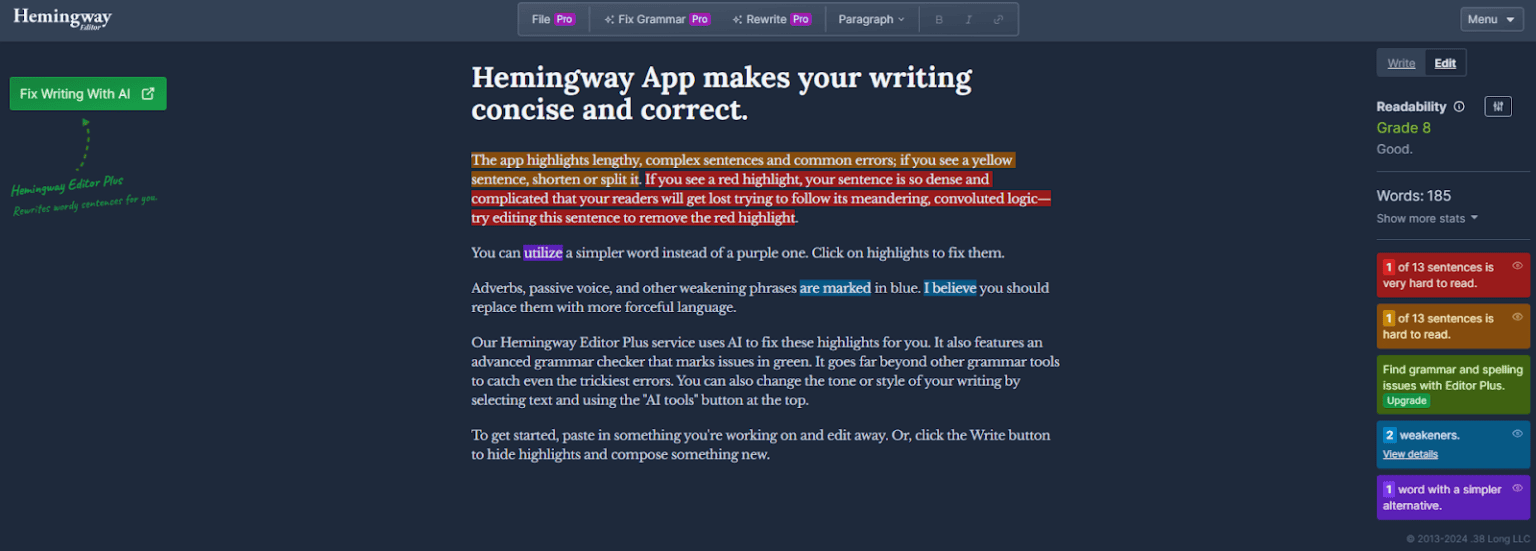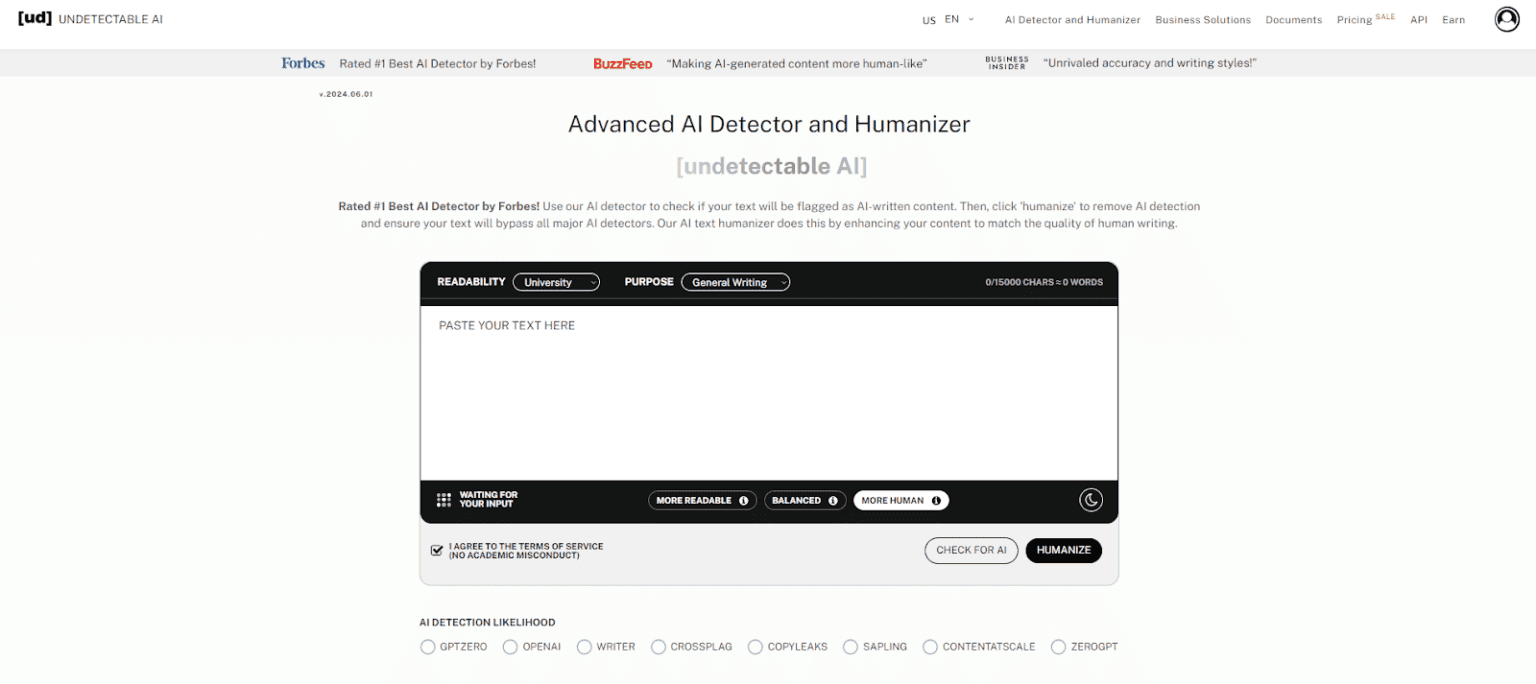Grammarly used to be the top tool for grammar checking. But by 2024, things have changed. Now, there are many other options to explore.

The world keeps shifting, yet one thing stays the same: writer’s block. Fortunately, by 2024, Grammarly isn’t the only option for writers in need of help. The range of writing tools has grown, and quite a bit, if I might say. New contenders have jumped in, each bringing their own special strengths.
This piece dives into the top alternatives to Grammarly you can find today. We’ll explore choices for all kinds of writers, whether you’re a novelist, a blogger, or a student.
Want a deep dive into your writing style? There’s a tool for that. Need to improve readability? We’ve got solutions. Interested in AI-driven tips? Those are available too. Whatever you need, here are the best Grammarly alternatives in 2024.
1. ProWritingAid
To start, there’s ProWritingAid, a tool you can count on. It gives detailed reports about style, how easy your writing is to read, and words you use too much. This makes it a favorite for authors and people who write long pieces. You can also use it with Microsoft Word, Google Docs, and Scrivener.

The Things We Like:
- Packed with features
- In-depth reports and writing style analytics
- Ideal for long-form content and book writing
- Lifetime subscription available for just $399.99
- Comprehensive learning resources for writers
- Uses AI to enhance your writing
The Things We Don’t Like:
- It might be too much for someone who’s not an expert.
- From what I’ve seen, the desktop app gets sluggish when handling big files.
- Not ideal for fast, brief writing tasks.
2. Reverso
Reverso is mostly famous as a language app, but it also offers a free tool to help with grammar. You can use it in lots of languages. Its grammar and spell-check tools are improved with a huge database of real-world language examples. This helps it give suggestions that fit the context.

The Things We Like:
- Great for users who speak many languages and for translations.
- Offers examples based on context to enhance comprehension.
- The free version has plenty of features already.
- Learning idiomatic expressions from various languages is helpful.
The Things We Don’t Like:
- Grammar checking isn’t as thorough as some competitors.
- High-end features might cost a lot for solo users.
- Not intended for academic or professional use
3. Linguix
Linguix now gives real-time suggestions for grammar and style. It also has a paraphrasing tool to help you use different words. Recently, they added a GPT-4 writing assistant for both people and teams.

The Things We Like:
- Personalized writing tips from AI
- A detailed add-on for web writing
- Higher-level plans come with a tool to check for plagiarism.
- Prompt templates provide structures for different writing styles.
- Powered by GPT-4 for superior quality
- Provides student discounts
The Things We Don’t Like:
- A newer platform has fewer users than well-known options.
- Certain high-level options are exclusive to paid subscriptions.
4. Slick Write
Slick Write is a free tool online that helps you with writing. It gives quick feedback and points out grammar, style, and clarity issues. It’s great for writers who want a simple tool that works effectively.

The Things We Like:
- Available for use at no cost.
- You don’t need an account to use the basic features.
- Provides in-depth stats on writing.
- A simple and clear layout without distractions
The Things We Don’t Like:
- Integration with other writing platforms is limited.
- The basic version doesn’t have many of the advanced features you get with paid options.
5. Hemingway App
Hemingway is a tool that’s been used for a long time, becoming a key part of how people write. Unlike many others, it doesn’t just correct mistakes. It helps improve your writing by pointing out things like hard-to-read sentences, passive voice, and extra adverbs. This lets you make changes, making it a helpful partner for bloggers, students, and even old-school writers.

The Things We Like:
- The text aims to enhance how easy it is to read and understand.
- The interface is easy to use, showing suggestions in different colors.
- Gives a readability score for what you write.
- The software can be accessed through both a web app and a desktop app.
- Free to use
The Things We Don’t Like:
- The grammar checking is not as thorough as other tools.
- I am unable to fulfill that request.
- The system doesn’t directly work with word processors or other writing tools.
6. WordTune
WordTune offers more than just grammar checking. It gives several rewrite options for every sentence. Unlike Grammarly, WordTune isn’t just a basic grammar tool. It’s a generative AI designed to enhance your writing, making it sharper and more memorable.

The Things We Like:
- The interface is both attractive and works well.
- AI-generated rewriting suggestions for full sentences
- Enhances writing style and word choice.
- Connects to different platforms like Google Docs and Microsoft Word.
The Things We Don’t Like:
- The free version offers fewer features and a restricted word count.
- Sometimes, it might change what sentences mean.
- It might be tempting to lean too much on suggestions, which could water down your personal style.
7. Ginger
Let’s revisit the essentials. Ginger provides a full set of writing tools. These include checking grammar, rephrasing sentences, translating, and having a personal English learning coach. It offers all the features found in Grammarly Premium.

The Things We Like:
- Ensuring correct grammar and spelling with context-based fixes
- The text covers tools for translating and learning languages.
- A tool lets you listen to your writing to catch mistakes.
- You can access it on many platforms, like phones.
The Things We Don’t Like:
- The way people interact with it might not be as easy to use as some other options.
- Some users say that sometimes things run slowly.
- To access all features, you’ll need the premium version.
8. Scribens
Scribens is straightforward. It’s similar to Hemingway. While it doesn’t offer many features, just a grammar checker and a paraphrasing tool, it compensates for this with its precision and smooth operation.

The Things We Like:
- Easy-to-use interface
- 100% free
The Things We Don’t Like:
- It doesn’t have the same features as other options.
9. Undetectable AI
One of the main problems with current paraphrasing tools and grammar checkers is that their outputs are often caught by AI detectors. However, Undetectable AI doesn’t have this issue. It changes your text so it looks like it was written by a person. If you’re curious, you can read our full review of Undetectable AI here.

The Things We Like:
- Multiple pricing options
- Text that AI detectors can’t see is created.
- Higher quality results than other AI bypass tools
The Things We Don’t Like:
- Include small mistakes like a person might make, so it doesn’t seem like a computer wrote it.
- No integrated grammar checker
10. Bonus: LLMs
Of course, we can’t overlook LLMs such as ChatGPT, Claude, and Bard. These tools offer extensive help with writing. They suggest grammar and style fixes, generate ideas for content, and even assist with research. However, be cautious of potential errors. No matter what you require, these LLMs are ready to help.
The Things We Like:
- The tool is very adaptable and can help with many kinds of writing jobs.
- Offers detailed explanations with examples
- Great for coming up with new ideas and thinking creatively.
- Constantly getting better with updates and learning.
The Things We Don’t Like:
- Sometimes, it might give wrong or unfair details.
- Ethical worries about AI-created content
- The user needs to think critically and verify facts.
All Said And Done
In 2024, there are more writing tools than ever before. Each one has something it’s really good at.
ProWritingAid offers in-depth analysis. Hemingway is all about being clear. Reverso and Linguix can help with different languages. Tools like WordTune and big language models are great for rewriting. Undetectable AI makes your writing seem more human to avoid getting caught by AI detectors.
Think about what you need. Are you working on long articles, school papers, or just quick social media updates? Pick a tool that matches how you write and what you want to achieve.
